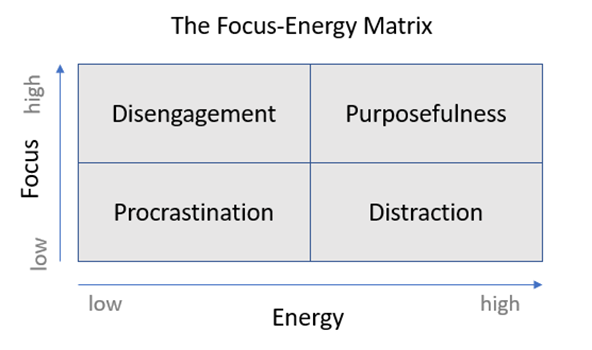Article's Content
It’s satisfying to check off all the items on your to-do list.
It feels like you’ve made your day count and can sleep at night knowing that you accomplished something.
But what exactly made up your to-do list?
Was it filled with email checking? Meetings that lead to more meetings? A lunch with someone who wanted to pick your brain? Or maybe five little tasks that, in a week, you’ll have to tackle all over again?
When we think of a busy person, we envision someone sitting at their desk with piles of paperwork, the phone ringing off the hook and notifications flying every which way. Rather than viewing it as a chaotic mess, we view it as a badge of honor.
Sociologist Christine Carter, Ph.D., an expert at UC Berkeley’s Greater Good Science Center, put it this way:
Busyness is not a marker of intelligence, importance, or success. Taken to an extreme, it is much more likely a marker of conformity or powerlessness or fear.
It’s time that we stop viewing busyness as something that we strive towards. It’s time for CEOs and executives to stop being busy and start being productive.
Let’s Stop Wearing ‘Busy’ As A Badge Of Honour
Busy has been viewed as a badge of honor when in reality, it should be rejected.
In 2002, Harvard Business Review published a piece called Beware Of The Busy Manager, an article that highlighted the findings of a study conducted to understand effectiveness in the workplace. The most daunting finding was this:
90% of managers squander their time in all sorts of ineffective activities. In other words, a mere 10% of managers spend their time in a committed, purposeful, and reflective manner.
There’s no question that executives and managers are under extreme pressure to deliver results. But this demonstrates that there is a serious inability for most managers to focus on purposeful actions.
In this article, they talk about two traits. The first trait is focus:
Focused managers aren’t in reactive mode; they choose not to respond immediately to every issue that comes their way or get sidetracked from their goals by distractions like e-mail, meetings, setbacks, and unforeseen demands. Because they have a clear understanding of what they want to accomplish, they carefully weigh their options before selecting a course of action.
The second trait is energy:
Energy is what pushes managers to go the extra mile when tackling heavy workloads and meeting tight deadlines.
While both of these traits are great to have when you only have one and not the other, dangerous workplace behavior can occur. Focus without energy can lead to burnout and energy without focus can lead to purposeless busyness. The Focus-Energy Matrix was formed to showcase the four different behaviors related to energy and focus:

The goal is to establish a sense of purpose in your work.
Only 10% of managers in the study were found in the top right quadrant. Managers who fall into that category are those who use their time effectively by choosing goals and taking deliberate action to reach them.
The largest quadrant at 40%, is a group of managers with high energy but low focus. The Distraction quadrant is where we find managers with great intentions but allow busyness to overcome their actions. A lack of focus results in these individuals creating work for themselves, scheduling meetings without a purpose and executing tasks that aren’t a priority.
Early in my career, I can remember working obsessively with the idea of constantly being busy. I would take on everything that came my way and embraced the challenge of being an internal Elon Musk. This approach resulted in me taking on far too many tasks over the course of a few months and having my manager set me down and explain that I needed to be willing to say no to projects and focus on my priorities.
Since then, I’ve taken many steps to move from the distraction quadrant to:
Identify Key Priorities For Each Week
Top-performing marketers avoid the trap of busyness by setting priorities.
At the beginning of each week, I set a few key priorities that need to have my attention. Sometimes that’s focused around product development and other times it’s focused around growth. Over the course of the week, this is where I focus my attention with a few blocks for flexibility to tackle things outside of my priorities.
Additionally, apps for work scheduling are valuable for identifying and organizing priorities, whether that be at an individual or team level.
Marissa Mayer, the CEO of Yahoo has a great philosophy on embracing prioritization for both her personal and professional life. When asked how she manages these two-time consuming tasks, being a mother and being a CEO, she always answers:
You have to ruthlessly prioritize.
I also love this quote from Jason Fried of Basecamp:
Some of the best “hard work” you can do is figuring our your priorities, and making tough calls about what’s not worth doing.
— Jason Fried (@jasonfried) January 12, 2016
I’ve met some great entrepreneurs over the years, and those who are the most successful spend very little time doing things that don’t make an impact. The best entrepreneurs are those who create systems not only for themselves but also for their teams that will optimize their time for productivity and output.
And it always begins with prioritization.
Ruthless and relentless prioritization.
Reject Distractions That Are Not On Task
Saying ‘no’ can give you the ability to do what matters.
I know. It’s not easy to say no because deep down you do want to help people. You want to chat about marketing and the impact that automated cars are going to have on the world. You want to chat about the latest app you found on product hunt and brainstorm ideas.
That’s fun.
But it’s rarely productive.
In a blog post from Dharmesh Shah, CTO and Co-Founder of Hubspot, he takes an example of an email he sends people who are looking to pick his brain or simply get his thoughts:
One of my biggest weaknesses in life is that I too often say yes. I’m passionate about startups. I get excited about new ideas. I love making new friends online. And, it’s so much easier to say yes than it is to say no. “Yes” is more fun and carries less guilt (in the short term).
However, I’ve learned the lesson that every time that I say yes to something new, I am effectively saying no to something else. And, I’ve already said yes to too many things, and so have to say “no” to you. No, I can’t accept a request for a call, a meeting or some time to review your startup or your business opportunity. Embarrassingly, I’m unlikely to be able to respond to your email (though I do read just about all of them).
Although my heart says yes, I MUST SAY NO.
What I like about this piece is that it gives a real perspective on how a lot of us feel. We’d love to actually take the time to meet with someone who just wants to chat but that time could have a cost if the conversation isn’t mutually beneficial.
Saying no to distractions allows you to focus on what matters most. Whether that be picking up a new side hustle to make money online, publishing more content—or even taking an online Spanish class, Saying no can give you time to be more productive. And saying no can give you the ability to avoid falling into the busyness trap.
This blog post from Julie Zhuo, Product Design Director at Facebook is a great resource that gives a simple guide to saying no. The template examples she offers up are awesome samples that you should be able to remix and reuse time and time again.
Practice Mindfulness On A Regular Basis
According to Psychology Today, mindfulness is a state of active, open attention on the present. In its Buddhist context, mindfulness meditation has three overarching purposes: knowing the mind; training the mind; and freeing the mind.
Over the last few months, I’ve been practicing mindfulness through yoga at least three times a week. It’s a habit that has helped me take a step back and become more aware of the big picture. It’s also armed me with a different perspective as it relates to dealing with temporary discomfort. It’s allowed me to take a more meaningful approach to my actions and communication.
Mindfulness in the form of meditation is practiced by some of the most successful people on the planet. From Oprah and Tim Ferriss to Russell Simmons and Kobe Bryant – It’s a practice that contributes a significant amount to their success.
Kobe Bryant identified meditation as one of the ways he started his day:
A team from the University of British Columbia and the Chemnitz University of Technology were able to pool data from more than 20 studies to determine which areas of the brain are consistently affected by mindfulness. In their studies, they identified the anterior cingulate cortex (ACC) as one of the major parts of the brain affected by meditation.
The ACC is associated with self-regulation, meaning the ability to purposefully direct attention and behavior, suppress inappropriate knee-jerk responses, and switch strategies flexibly. People with damage to the ACC show impulsivity and unchecked aggression, and those with impaired connections between this and other brain regions perform poorly on tests of mental flexibility: they hold onto ineffective problem-solving strategies rather than adapting their behavior.
And this is just the beginning as it relates to the benefits of mindfulness. When you combine mindfulness with yoga, it can be good for your health as well. And as a result, it arms you with the ability to be both healthier and more focused. It’s a win-win.
Monitor & Optimize Your Actual Efforts

I track my time and efforts through my calendar and review it once my week is over. I do this to better understand what I’m doing with my time and ensure that it’s actually aligned with my goals and priorities. If it doesn’t line up appropriately, I can recognize the issues and ensure that they don’t occur the following week.
It’s hard to know if you’re focused on the right things if you’re not keeping track of where you’re spending your time; however, you can use tools to help manage tasks and track progress.
And if you’re managing a team, you have options when it comes to time tracking, including employee time tracking software to help you boost the productivity of others.
We often go through our week by simply moving through the motions. This activity is what leads us down a path of busyness rather than purposefulness.
Don’t let it happen.
Track your time. Track your efforts.
And once you’ve taken a look at where your time is actually being spent, optimize it moving forward to be more aligned with the goals and objectives you’re hoping to accomplish.
Conclusion…
By understanding the importance of focus and walking away from the trap of busyness, you can be more effective and efficient in your actions. Avoid the trap of being busy by being more mindful, monitoring your efforts, optimizing them, learning to say no, and moving into a state of purposefulness.








